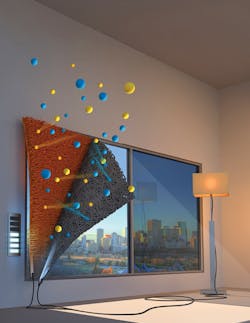Transparent molybdenum oxide-based smart windows store energy like a battery

Materials capable of simultaneously modulating light transmission and storing electrochemical energy would be invaluable as “green” smart window platforms and/or displays for homes and businesses. While electrochromic materials—those that can change in color or opacity by applying voltage—are often considered for these applications, attaining useful energy storage requires the injection of large charge densities that correspondingly degrade their coloration efficiency, limiting device performance.
Professor Abdulhakem Elezzabi and his research group at the University of Alberta (Edmonton, AB, Canada) have overcome this limitation by developing a hybrid nanocomposite material consisting of colloidal nanocrystalline molybdenum oxide (MoO3) dispersed within a tungsten-molybdenum-oxide (W0.71Mo0.29O3) nanowire matrix, simultaneously yielding 100% enhanced energy capacity and 50% optical contrast modulation. Essentially, the team turned a smart window into a high-capacity rechargeable battery. Using an inexpensive and scalable process of applying the hybrid MoO3-W0.71Mo0.29O3 films with a spray-coating technique, electrical energy can be stored in the window while colored, and recovered on demand to power electrical devices. An 8 × 8 cm prototype of the window exhibited fully reversible contrast switching and can power a light-emitting diode (LED) for around 10 min. after inducing coloration with a -2.5 V signal for 1 min. The window has a Coulombic efficiency of 66% and a capacity of 2.33 mAh/m2, which is a factor of 1.5 and 1.6 better, respectively, than the best switchable windows composed of inkjet-printed CeO2/TiO2 and WO3/poly(3,4-ethylenedioxythiophene)-poly(styrene sulfonate) films fabricated to date. Reference: H. Li et al., Nano Energy, 47, 130–139 (2018).
About the Author

Gail Overton
Senior Editor (2004-2020)
Gail has more than 30 years of engineering, marketing, product management, and editorial experience in the photonics and optical communications industry. Before joining the staff at Laser Focus World in 2004, she held many product management and product marketing roles in the fiber-optics industry, most notably at Hughes (El Segundo, CA), GTE Labs (Waltham, MA), Corning (Corning, NY), Photon Kinetics (Beaverton, OR), and Newport Corporation (Irvine, CA). During her marketing career, Gail published articles in WDM Solutions and Sensors magazine and traveled internationally to conduct product and sales training. Gail received her BS degree in physics, with an emphasis in optics, from San Diego State University in San Diego, CA in May 1986.